To heal diabetic foot ulcers, consider using LED therapy, which boosts recovery by enhancing cellular healing. It works by penetrating the skin to stimulate ATP production, improving circulation and reducing inflammation. Studies show that ulcers treated with LED therapy heal 4.65 times more effectively compared to standard methods, with recovery rates hitting 78.4% when combined with other therapies. Aim for daily treatments over 12 to 20 weeks for ideal results. Remember, proper wound care is essential. As you explore this guide, you'll uncover more tips and insights to maximize your healing journey.
Overview of Diabetic Foot Ulcers
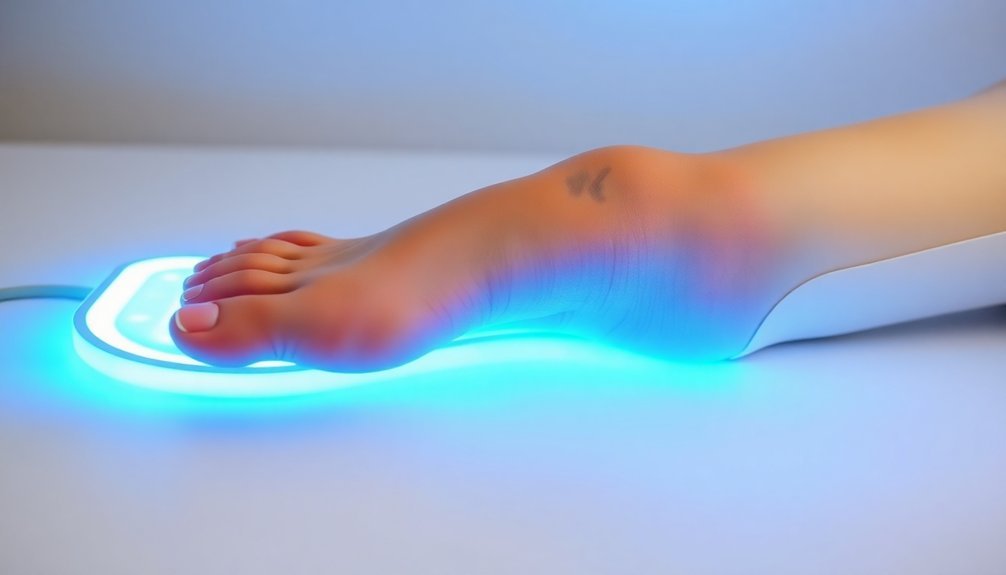
Diabetic foot ulcers are serious wounds that develop due to prolonged pressure, poor circulation, and nerve damage in individuals with diabetes. They're common, affecting about 15% of diabetic patients, with many of them found on the bottoms of your feet.
In fact, around one-third of people with diabetes will face a foot ulcer during their lifetime, which impacts around 18.6 million individuals worldwide and 1.6 million in the U.S. each year.
Several risk factors can contribute to the development of these ulcers. Peripheral neuropathy greatly diminishes your ability to feel pain and pressure in your feet. Additionally, foot deformities like bunions and hammer toes increase your ulceration risk. Importantly, early intervention can significantly reduce the likelihood of complications and amputations when foot ulcers are identified and treated promptly.
Poor circulation or a history of amputations also play a role.
Complications can be severe; about 50% of diabetic foot ulcers become infected, with 20% leading to amputations. Recurrence is common, with 40% of ulcers coming back within a year.
Understanding the risks and prevalence of diabetic foot ulcers helps you take necessary preventive steps and seek early treatment to protect your feet.
Mechanism of Red Light Therapy
Red light therapy, a promising treatment option, harnesses the power of specific wavelengths of light to promote healing at the cellular level. By penetrating the skin up to 8-10 millimeters, red and near-infrared light interacts with mitochondrial protein cytochrome c oxidase (CCO), markedly boosting ATP production.
This increase in energy enhances several essential processes:
- Tissue Repair: Higher ATP levels accelerate the repair of damaged tissues and stimulate cell proliferation.
- Circulation Improvement: Enhanced blood flow delivers more oxygen and nutrients to affected areas, forming new capillaries and improving vascular health.
- Anti-inflammatory Effects: Red light therapy reduces inflammation, edema, and pain while promoting overall healing.
Moreover, this therapy modulates gene expression and generates critical cell signaling molecules, positively impacting cellular energy and metabolic processes. This process has been cleared by the U.S. Food and Drug Administration (FDA) to treat conditions such as slow-to-heal wounds.
As it aids in waste removal and collagen production, your body becomes better equipped to manage conditions like diabetic foot ulcers.
Clinical Evidence Supporting Efficacy
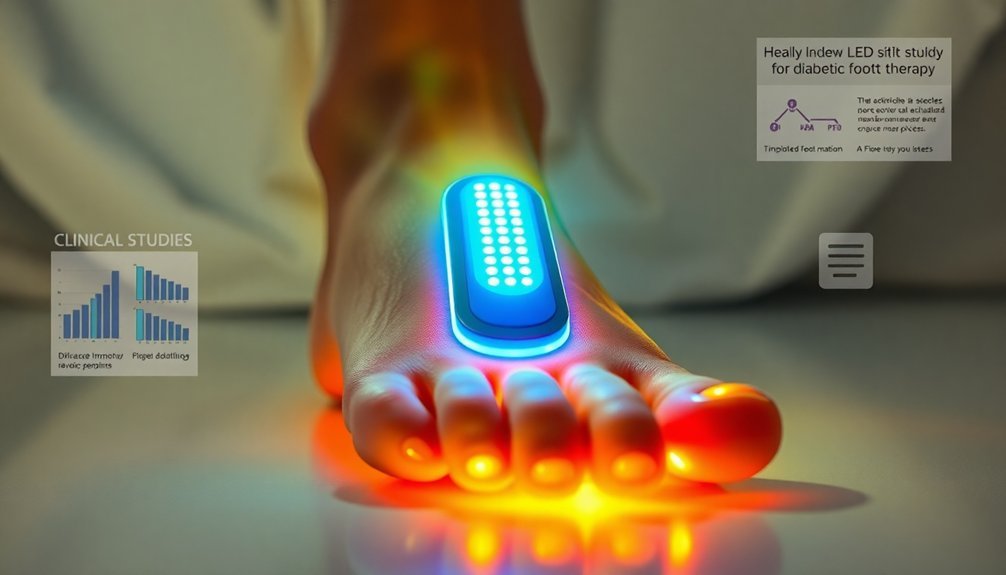
Emerging clinical evidence strongly supports the efficacy of low-level light therapy (LLLT) in treating diabetic foot ulcers. A meta-analysis that included 12 randomized controlled trials revealed a noteworthy 30.90% reduction in ulcer area for patients receiving LLLT compared to those in the control group. Specifically, you can expect about a 4.2 cm² reduction in ulcer area when using this therapy.
Four randomized controlled trials involving 131 participants showed positive therapeutic outcomes with LLLT, highlighting its safety with no adverse events reported. In particular, studies indicated that infrared LED therapy had remarkable effects on wound healing. You'd find that diabetic foot ulcers treated with LLLT were 4.65 times more likely to heal completely compared to those who didn't receive the treatment.
The follow-up periods of 2 to 16 weeks illustrated appreciably accelerated healing times for those utilizing LLLT. The efficacy was consistent across multiple trials, providing strong evidence that LLLT can effectively enhance healing rates and decrease ulcer size. Moreover, diabetes complications, such as the 25% lifetime risk of developing diabetic foot ulcers, highlight the urgent need for effective treatments like LLLT.
As more studies emerge, it's essential to continue investigating LLLT's potential to further validate these promising results and refine treatment protocols.
Patient Outcomes With LED Therapy
When considering treatment options for foot ulcers, patients often experience remarkable outcomes with LED therapy. This innovative approach not only speeds up healing but also improves overall comfort.
Numerous studies reveal significant benefits from using LED phototherapy, including:
- Wound Healing Rates: Research shows that using red and infrared LEDs can lead to a substantial reduction in ulcer size, with recovery rates soaring to 78.4% when combined with natural latex insoles.
- Pain Reduction: Many patients report a notable decrease in pain during treatment, directly linked to reduced inflammation and oxidative stress in the wound area. This leads to an enhanced quality of life.
- Tissue Repair and Regeneration: LED therapy promotes collagen production, increases fibroblast activity, and enhances blood circulation, all essential for tissue repair.
Ultimately, LED phototherapy proves to be a safe, cost-effective solution for diabetic foot ulcers.
With minimal supervision needed, patients can perform treatments at home comfortably and confidently, aiming for improved outcomes and preventing complications like amputations.
Recommended Treatment Parameters
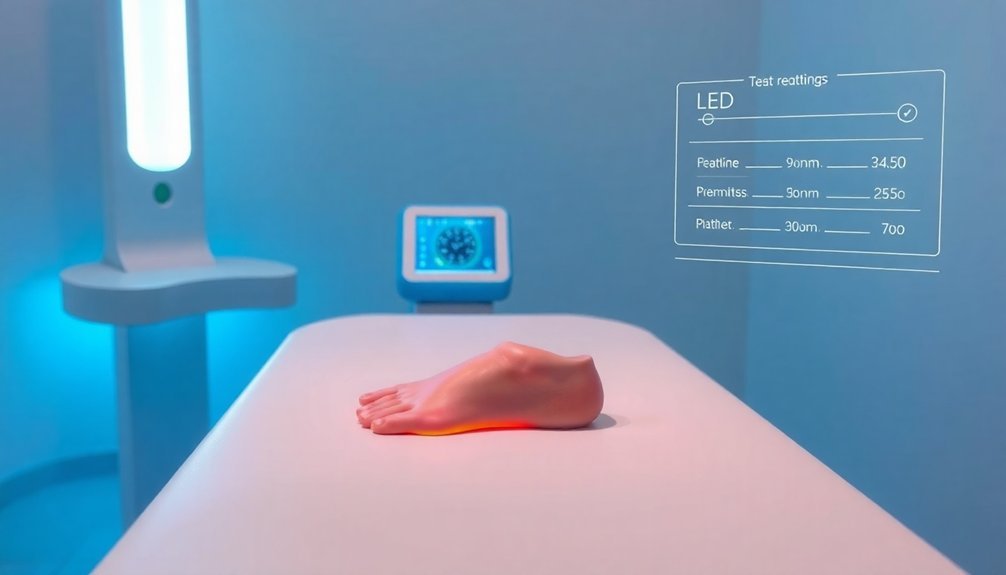
When treating diabetic foot ulcers with LED therapy, understanding the recommended treatment parameters is essential for achieving the best outcomes.
You'll want to focus on ideal device settings and appropriate treatment durations while considering the benefits of combination therapies.
Getting these details right can greatly enhance your healing journey.
Treatment Duration Recommendations
Effective treatment duration is vital for the successful healing of diabetic foot ulcers (DFUs) with LED therapy. Studies suggest that you should aim for a treatment duration between 12 to 20 weeks for ideal results.
It's essential to adhere to daily treatment sessions, especially over an initial period of at least 2 weeks to start observing healing effects. Here are some key recommendations for treatment duration:
- Daily Treatments: Engage in daily LED therapy for a minimum of 12 weeks, ensuring consistency and maximizing outcomes.
- Regular Follow-Up: Schedule follow-up assessments at 1, 30, 60, and 90 days, plus an additional evaluation 30 days after treatment ends to gauge healing continuity.
- Interim Evaluations: Monitor progress through interim evaluations at 30 and 60 days, allowing for necessary adjustments to the treatment plan based on the ulcer's healing response.
Following these guidelines can greatly enhance your healing process, reduce ulcer size, and improve overall foot health.
Optimal Device Settings
Choosing the right device settings is essential for maximizing the benefits of LED therapy in healing diabetic foot ulcers.
Start with the effective wavelengths; studies suggest using 633 nm and 810 nm, with 633 nm being particularly effective for diabetic and burn wounds.
Aim for a recommended fluence of 4.71 J/cm² for diabetic burns and 2.35 J/cm² for diabetic wounds. Higher fluencies can hinder healing, so sticking to these values is essential.
Treat your ulcers three times a week for ideal results, as frequent treatments without going daily have shown better efficacy.
Consistency is key, but you may need to adjust the frequency based on individual responses.
For application, consider using an LED matrix directly on the wound area or a combination system.
Combination Therapy Benefits
Combining LED therapy with conventional treatment offers considerable advantages for healing diabetic foot ulcers. By integrating red and infrared light therapy, you can enhance the wound healing process markedly.
Here's what you can expect from this combination therapy:
- Enhanced Wound Healing: You'll notice faster reduction in wound size, increased granulation tissue, and improved collagen production, thanks to the increased cell activity from red light therapy.
- Improved Microcirculation: This therapy can boost blood flow, which means more oxygen and nutrients reach the wound site. This improved circulation accelerates healing and reduces inflammation.
- Multimodal Treatment Approach: Using both red and infrared LEDs together leads to quicker recovery rates. Adding supportive devices like natural latex insoles enhances comfort during your healing journey.
Clinical studies reveal that combination therapy yields a recovery rate of 78.4%, considerably higher than the standard treatment's 51.8%.
With compelling statistics favoring this approach, it's clear that combining LED therapy with conventional methods not only speeds healing but also enhances your overall treatment experience.
Incorporate this strategy to maximize your results.
Safety and Side Effects
LED therapy is generally recognized for its safety and minimal side effects when treating diabetic foot ulcers. This non-invasive procedure doesn't involve any surgical intervention, ensuring comfort during treatment. The low-power light used in LED therapy generates no heat, allowing for a comfortable experience. This therapy penetrates deep into the tissue, reaching 8-10 millimeters without causing damage.
Patients typically tolerate LED therapy well, experiencing minimal side effects. You won't feel pain or discomfort, and allergic reactions are exceedingly rare. Some individuals may notice temporary changes in skin sensitivity, but these effects are transient and usually resolve quickly. Importantly, LED therapy doesn't lead to systemic side effects; it's applied locally to the affected area.
Furthermore, you can safely combine LED therapy with conventional treatments for diabetic foot ulcers. There are no reported adverse interactions between these therapies or with medications used for diabetes management. By monitoring individual responses and adjusting treatment plans as necessary, you can maximize healing and improve outcomes.
Cost-Effectiveness of LED Therapy
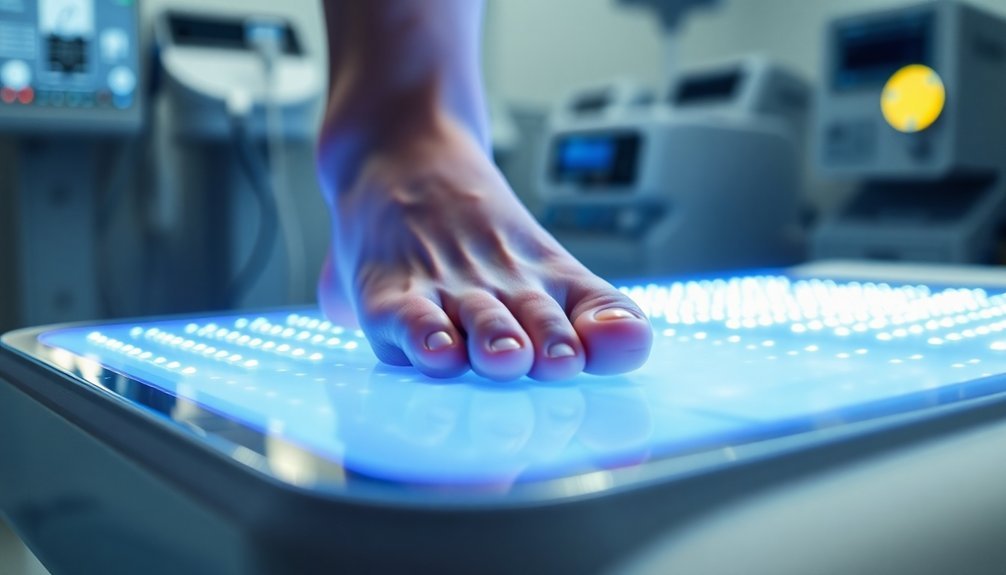
While traditional treatment options for diabetic foot ulcers can be effective, many patients and healthcare providers are increasingly evaluating the cost-effectiveness of LED therapy. Studies reveal that LED therapy can greatly reduce ulcer areas more effectively than standard care. Though direct cost comparisons are lacking, there's potential for lower overall costs due to factors like reduced hospitalization and amputation rates.
Here are three key points to evaluate:
- Faster Healing: LED therapy accelerates wound healing and improves healing indices, which may lead to fewer complications and lower costs over time.
- Less Invasive: This therapy is minimally invasive and easy to use, possibly reducing the need for professional care and frequent hospital visits.
- Reduced Long-term Costs: With fewer major treatments required, such as amputations, the long-term financial burden on the healthcare system could decrease greatly.
Although more research is needed to fully assess the cost-effectiveness of LED therapy compared to other treatments, early indications suggest it offers promising advantages that can benefit both patients and healthcare providers alike.
Future Research Directions
As we look toward future research directions, you might consider the expanded application areas for LED therapy beyond diabetic foot ulcers.
It's vital to establish rigorous clinical testing requirements to validate its effectiveness across different conditions. This will help guarantee that treatment protocols aren't only effective but also widely applicable in various healthcare settings.
Expanded Application Areas
The potential of expanding application areas for LED therapy is exciting and holds promise for enhancing patient outcomes. Not only does it have a significant role in wound healing, but future studies could explore its benefits in various domains relevant to diabetes management and beyond.
Consider these potential avenues for expanded application:
- Blood Sugar Management: Research shows red light therapy can reduce blood sugar levels by nearly 30%. Understanding its role in glucose metabolism opens new doors for diabetes control.
- Sleep and Circadian Rhythm: Evidence suggests LED therapy improves sleep quality among older type 2 diabetes patients. Enhanced sleep could contribute to better overall health outcomes.
- Broader Wound Types: LED therapy's application isn't limited to diabetic foot ulcers. It has shown promise in treating venous ulcers and even nipple trauma, potentially accelerating healing for various tissue injuries.
These directions highlight how LED therapy could integrate into holistic care, serving as a powerful tool beyond traditional treatments.
As research continues, we may discover even broader implications for this innovative therapy in enhancing health and well-being.
Clinical Testing Requirements
Clinical testing requirements for LED therapy in diabetic foot ulcers necessitate rigorous study designs. You'll need to conduct randomized controlled trials to effectively compare LED therapy against standard wound care.
Select participants carefully—target diabetic patients aged 30 to 65 with grade I or II ulcers, considering those with chronic venous ulcers as well. It's important to standardize ulcer size and location while evaluating the presence of ischemia or infection during patient selection.
Interventions should involve daily or periodic LED light exposure at various wavelengths, while control groups receive standard care without LED therapy. Duration for these studies should range from 4 to 12 weeks to evaluate both immediate and long-term effects.
Measuring outcomes is equally significant, so track the wound healing index, mean skin temperature, and pain levels using standardized scales. Safety assessments are crucial too; document any adverse effects during the trial.
Finally, statistical analysis must include intention-to-treat evaluations with a significance level set at 5%. This structured approach will help you gather reliable data, demonstrating the efficacy and safety of LED therapy in healing diabetic foot ulcers.
Alternative Applications of LED Therapy
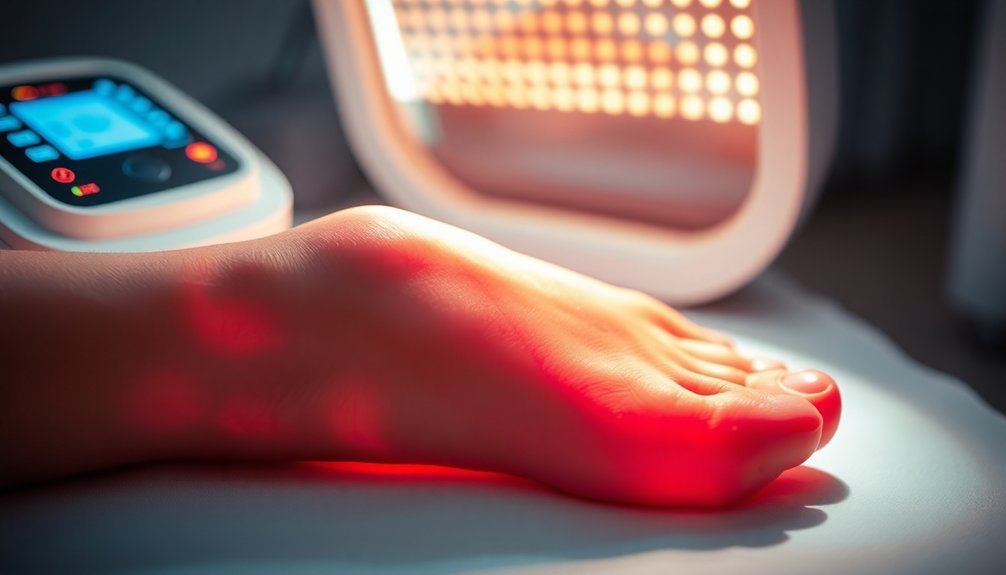
LED therapy's versatility extends beyond just treating diabetic foot ulcers, showcasing alternative applications that can greatly enhance health outcomes. Many individuals find relief and healing through various forms of LED therapy, benefitting from its non-invasive and effective nature.
Here are three notable alternative applications:
- Wound Healing and Tissue Repair: Low-level LED light promotes cellular repair while reducing inflammation. This is particularly effective in enhancing collagen production and blood circulation, essential for tissue repair.
- Dermatological Treatments: Red light therapy boosts collagen production and reduces inflammation, while blue light therapy serves to combat acne and other skin cancers. Combined therapies can effectively target inflammatory acne lesions, offering robust skin health solutions.
- Pain Management: Near-infrared LED light penetrates deeper to alleviate muscle and joint pain, reducing inflammation right at the source. This offers a safer and more comfortable alternative to traditional laser therapy.
Combining Therapies for Better Results
Combining various therapies can greatly enhance healing outcomes for diabetic foot ulcers. For instance, coupling LED therapy with pharmacological treatments like insulin and metformin can considerably accelerate healing. Metformin levels increase at the wound site, promoting faster recovery. This synergy could transform approaches to managing chronic wounds, according to recent studies funded by the National Institute of Diabetes and Digestive and Kidney Diseases.
Integrating growth factor treatments, such as becaplermin, can also be beneficial. This FDA-approved factor boosts cell recruitment and granulation tissue formation, essential for healing diabetic ulcers. However, consider potential adverse effects associated with its use.
You might also explore natural agents like honey therapy. Varieties like manuka show promising results in wound contraction and healing, reducing inflammation while enhancing outcomes.
Additionally, stem cell therapy can promote healthy blood flow and collagen formation, providing a conducive environment for recovery.
Finally, don't overlook the role of proper wound dressings and photobiomodulation, which can support the healing process. By adopting a multi-faceted approach, you'll maximize your chances of achieving better results in treating diabetic foot ulcers.
Getting Started With LED Treatment
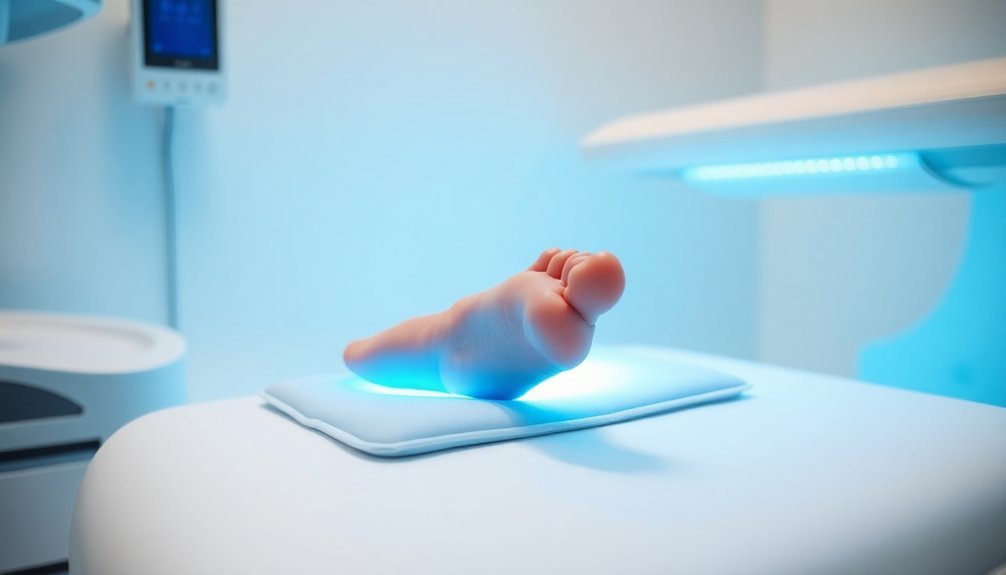
Before diving into LED treatment for diabetic foot ulcers, it's vital to prepare both the patient and the wound properly. Start by thoroughly cleaning the ulcer with 0.9% physiological saline and gauze to guarantee a sterile environment.
Then, make certain the patient is resting on a sofa or bed; avoid any walking during the procedure since rest is critical for healing.
Here are three key steps to follow when setting up your treatment:
- Prepare the Insole and Latex Sheet: Fabricate a custom-made insole from natural latex, creating a gap at the ulcer site. Seal a latex sheet over the wound, covering its entirety.
- Set Up the LED Device: Use a device with red LEDs (635 nm wavelength), strapping it to the insole so it radiates light effectively onto the latex-covered wound. Secure it with plastic wrap to maintain cleanliness.
- Guarantee Proper Monitoring: Regularly assess wound healing and compare healing rates by measuring various indices, and consistently following up as directed.
With these steps, you'll be well on your way to effective LED treatment.
Frequently Asked Questions
How Quickly Can I See Results From LED Therapy?
You should start seeing results from LED therapy within a few weeks, as many studies report substantial healing progress after 4 weeks of consistent treatment. Regular sessions can enhance your recovery timeline considerably.
Can LED Therapy Be Used for Other Skin Conditions?
Yes, LED therapy's effective for various skin conditions. It reduces redness in psoriasis, eases herpes lesions, stimulates hair growth, and improves overall skin texture. You'll likely notice significant benefits with consistent treatment.
Is LED Therapy Safe for All Ages?
LED therapy's generally safe for most ages, but it's recommended for those 14 and older. Be cautious if you have specific health conditions, and always consult a healthcare provider to verify it's suitable for you.
How Do I Maintain My LED Therapy Device?
To maintain your LED therapy device, clean it regularly with a soft cloth, store it in a cool, dry place, inspect for damage, and follow the manufacturer's guidelines for ideal performance and longevity.
Are There Lifestyle Changes Needed During LED Treatment?
During LED treatment, you should focus on maintaining blood sugar levels, practicing foot hygiene, staying physically active, and following a balanced diet. These lifestyle changes can enhance your treatment's effectiveness and promote better healing outcomes.
In Summary
To sum up, LED therapy can be a game-changer for healing diabetic foot ulcers. By harnessing the mechanisms of red light, you're not just promoting tissue regeneration but also improving patient outcomes. As you explore this innovative treatment, consider combining it with other therapies for enhanced effectiveness. With ongoing research and a clearer understanding of LED's potential, you can confidently take the next step in managing foot ulcers and improving your quality of life.

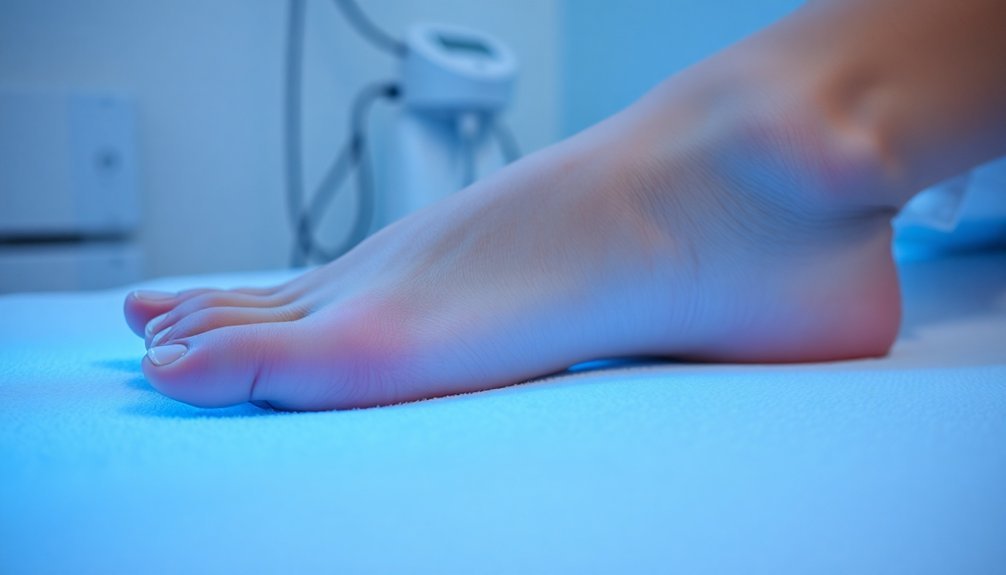



Leave a Reply